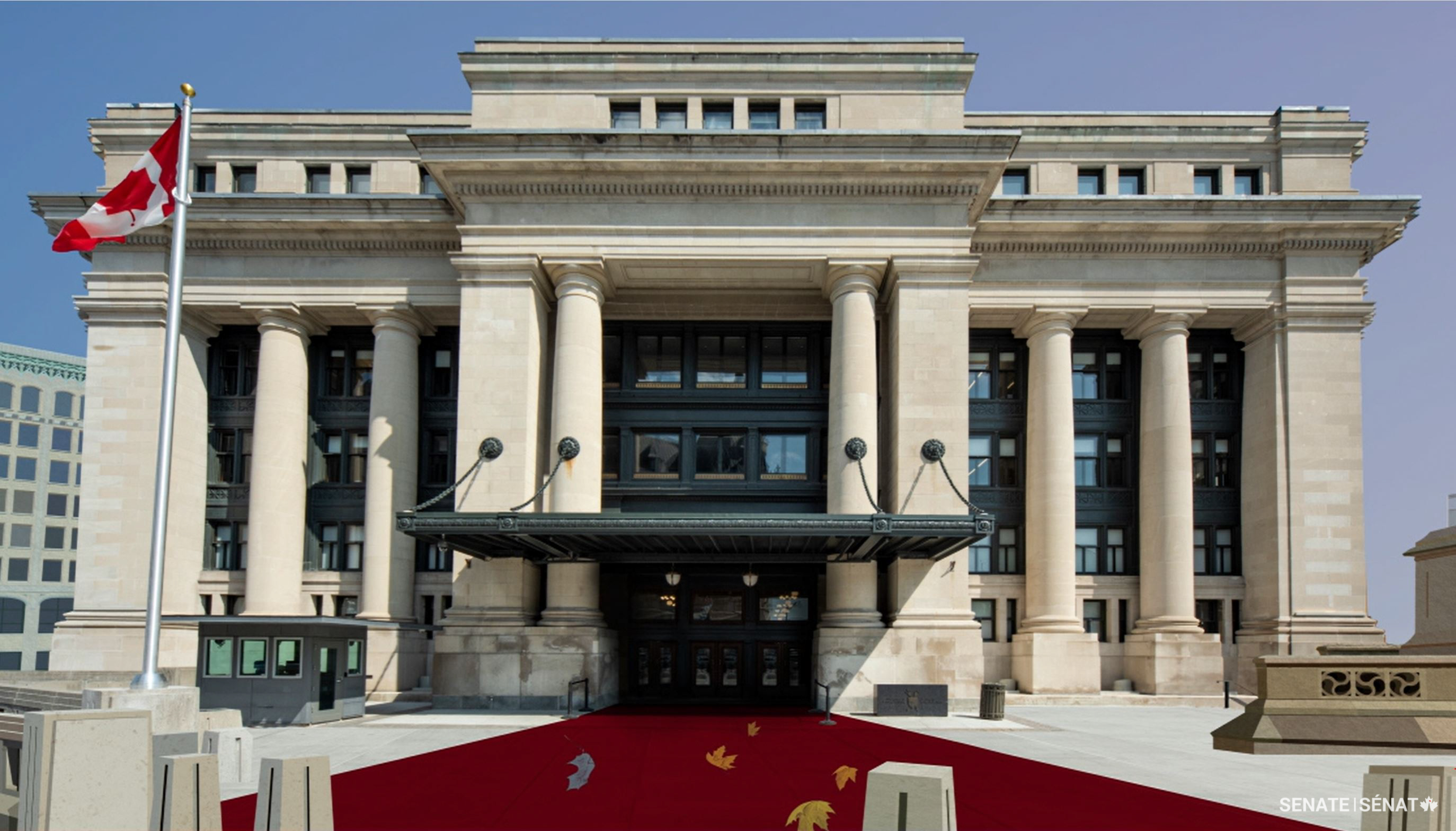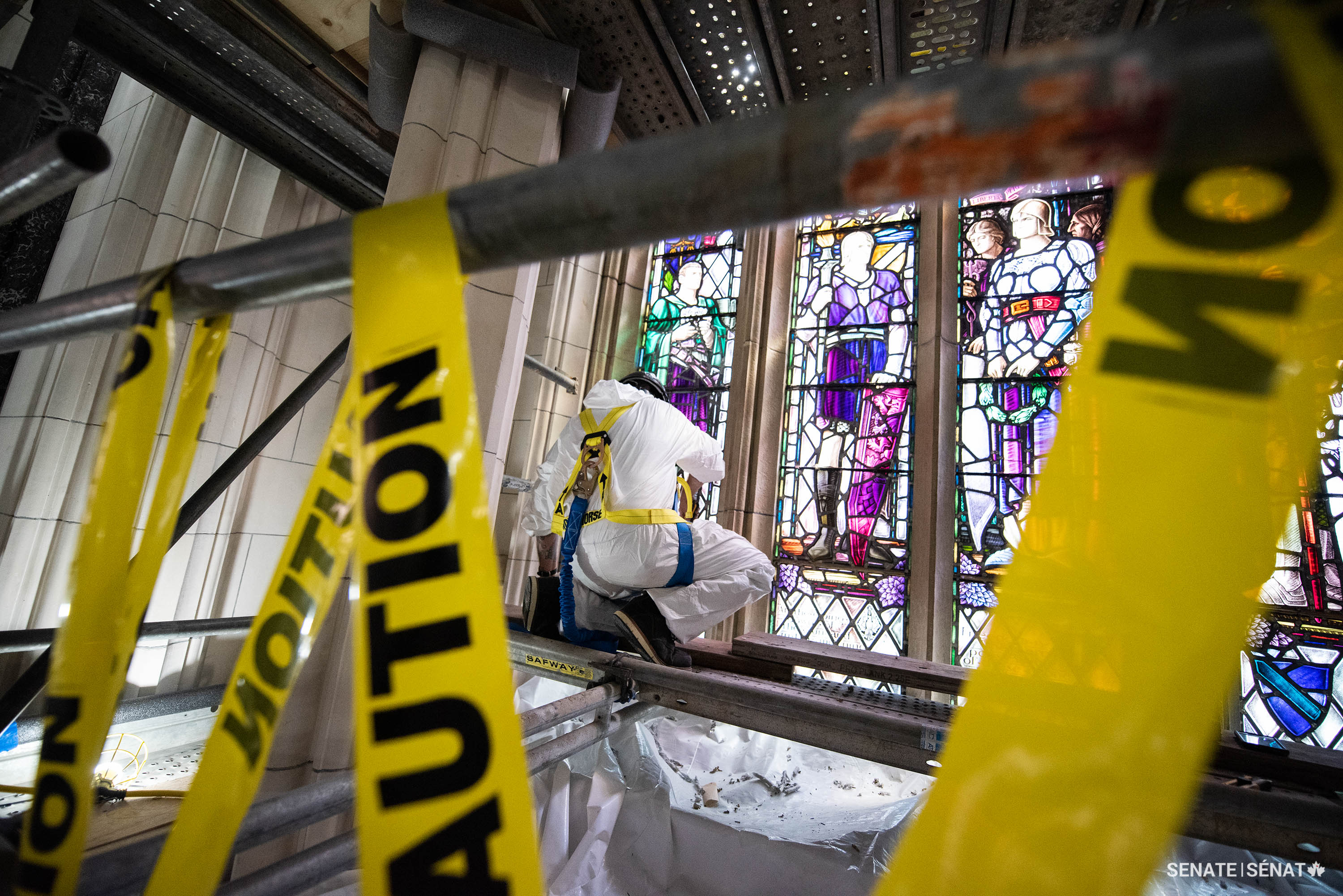2022 in review: The Senate’s most-read articles about Parliament Hill’s rehabilitation

In February 2019, the Senate moved to the Senate of Canada Building, a former train station built in 1912. The Senate will occupy this temporary location while Parliament’s Centre Block — the Senate’s permanent home — is rehabilitated.
Although Centre Block is shuttered for rehabilitation work, Canadians can still experience its art and architecture through the Senate’s immersive virtual tour.
2022 marked the fourth year of the major rehabilitation of Centre Block on Parliament Hill.
The century-old building — the permanent home of the Senate, the House of Commons and the iconic Peace Tower — is the site of the biggest heritage restoration project in Canada’s history.
Over the coming years, Centre Block will be brought up to modern safety, accessibility and sustainability standards so it can continue to serve Canadians for decades to come, an effort overseen in part by the Senate’s Subcommittee on Long Term Vision and Plan.
With every passing year, the range of construction and conservation activities continues to expand and unearth fascinating tales about Centre Block’s history and the treasures within. Recent work has included everything from earthquake fortification to the restoration of stained-glass windows.
Check out the top five most-read articles about the rehabilitation work in 2022:
 Centre Block’s foundation is partly excavated for seismic upgrades. The entire building will eventually float on a grid of steel and reinforced concrete, which will rest on shock-absorbing base isolators.
Centre Block’s foundation is partly excavated for seismic upgrades. The entire building will eventually float on a grid of steel and reinforced concrete, which will rest on shock-absorbing base isolators.
1. Seismic Solutions: How Centre Block will be prepared to withstand earthquakes
On the afternoon of June 23, 2010, Ottawa was shaken by a magnitude 5.0 earthquake — the strongest ever recorded in the National Capital Region. The event spotlighted the fact that Ottawa’s heritage buildings are susceptible to earthquake damage.
Upgrading Centre Block to meet modern seismic standards has been one of the first orders of business during the building’s rehabilitation!
Read the full article about Centre Block’s seismic upgrades.
 Workers carefully lower a long section of detached wooden fretwork. Featuring intricate crests, fleurs-de-lis and rosettes, this fretwork is the upper pattern of the frieze that wraps around Centre Block’s Senate Chamber. (Photo credit: Heritage Grade)
Workers carefully lower a long section of detached wooden fretwork. Featuring intricate crests, fleurs-de-lis and rosettes, this fretwork is the upper pattern of the frieze that wraps around Centre Block’s Senate Chamber. (Photo credit: Heritage Grade)
2. Disassembling the woodwork in the Red Chamber and Senate Reading Room
Heritage conservators and skilled carpenters have been carefully dismantling century-old decorative woodwork in Centre Block.
This massive job has unfolded over months. It requires extensive research, meticulous cataloguing and expertise in heritage construction and conservation. The experts recruited for the task have had to solve the puzzle of how the woodwork was assembled and installed, and then work backwards.
In some cases, the woodwork’s removal has revealed some surprises from the past!
Read the full article about the dismantling of the Senate’s woodwork.
 Conservator David Legris uses a cotton swab and mild solvents to gently remove surface grime and layers of yellowed varnish from the Senate’s portrait of King George III.
Conservator David Legris uses a cotton swab and mild solvents to gently remove surface grime and layers of yellowed varnish from the Senate’s portrait of King George III.
3. A Royal Portrait’s Passage: Navigating the uncharted past of a Senate treasure
History has not been kind to King George III. But the Senate’s portrait of the former British monarch — which hung in Centre Block’s Senate foyer until recently — depicts him as an exemplary ruler, radiating self-confidence and grandeur.
When restoration of the 230-year-old portrait began, little-known details about its arrival in Canada began to emerge. It’s a story that brings together three of the most riveting personalities of the 18th century: the much-maligned king who gained and lost half a continent, the most celebrated portraitist of the century and the pragmatic governor who prevented the fall of Quebec.
Read the full article about the Senate’s portrait of King George III.
 A screenshot from the Senate of Canada Building Virtual Tour, which offers a digital exploration of Ottawa’s old central train station — the Senate’s temporary home while Centre Block is rehabilitated. This immersive and interactive 360-degree experience lets users explore the history, art and architecture of this historic building.
A screenshot from the Senate of Canada Building Virtual Tour, which offers a digital exploration of Ottawa’s old central train station — the Senate’s temporary home while Centre Block is rehabilitated. This immersive and interactive 360-degree experience lets users explore the history, art and architecture of this historic building.
4. New virtual tour shows off the Senate of Canada Building
The doors to the Senate of Canada Building are now virtually open to visitors all over the world!
An online tour of the former train station, launched in March 2022, allows guests to virtually experience the architecture, art and history of this grand building — the Senate’s temporary home during Centre Block’s rehabilitation.
The engine behind the virtual tour is the Carleton Immersive Media Studio (CIMS), an internationally renowned research team affiliated with Ottawa’s Carleton University. The 10-person team spent months turning the 110-year-old Beaux-Arts building into an online panorama.
Read the full article about the Senate of Canada Building Virtual Tour.
 Workers delicately remove a section of The Assembly of Remembrance from the Memorial Chamber in Centre Block.
Workers delicately remove a section of The Assembly of Remembrance from the Memorial Chamber in Centre Block.
5. Refurbishing the Memorial Chamber’s stained glass
The Memorial Chamber is one of Canada’s most sacred spaces. It honours Canada’s war dead and holds the Books of Remembrance in which their names are recorded.
Inside the chamber, elaborate stained-glass windows filter and colour the daylight. The windows — created by artist and First World War veteran Frank S.J. Hollister and installed in 1927 — show scenes of war and peace, from the call to arms to the remembrance of the fallen.
After they were removed for their protection during Centre Block’s rehabilitation, expert conservators began refurbishing these precious works of art for future generations of Canadians.
Read the full article about the Memorial Chamber’s stained glass.


